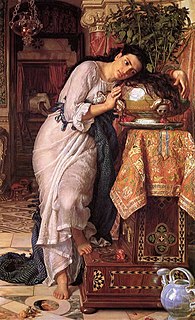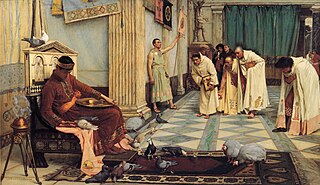
Circe is an enchantress and a minor goddess in Greek mythology. She is either a daughter of the god Helios and the Oceanid nymph Perse or the goddess Hecate and Aeetes. Circe was renowned for her vast knowledge of potions and herbs. Through the use of these and a magic wand or staff, she would transform her enemies, or those who offended her, into animals.

In Greek mythology, Scylla is a legendary monster who lives on one side of a narrow channel of water, opposite her counterpart Charybdis. The two sides of the strait are within an arrow's range of each other—so close that sailors attempting to avoid Charybdis would pass dangerously close to Scylla and vice versa.
In Greek mythology, Eurylochus appears in Homer's Odyssey as second-in-command of Odysseus' ship during the return to Ithaca after the Trojan War. He also was the husband of Odysseus's sister, Ctimene. He is portrayed as an unpleasant cowardly individual who undermines Odysseus and stirs up trouble.

John William Waterhouse was an English painter known for working first in the Academic style and for then embracing the Pre-Raphaelite Brotherhood's style and subject matter. His artworks were known for their depictions of women from both ancient Greek mythology and Arthurian legend.
Giovanni Benedetto Castiglione was an Italian Baroque painter, printmaker and draftsman, of the Genoese school. He is best known now for his etchings, and as the inventor of the printmaking technique of monotyping. He was known as Il Grechetto in Italy and in France as Le Benédette.

Circe is a fictional supervillain appearing in DC Comics publications and related media. Based upon the Greek mythological figure of the same name who imprisoned Odysseus in Homer's Odyssey, she is a wicked sorceress and recurring foe of Wonder Woman.
USS Circe (AKA-25) was an Artemis-class attack cargo ship named after the asteroid 34 Circe, which in turn was named after Circe, a goddess or sorceress in Greek mythology. USS Circe served as a commissioned ship for 18 months.

The Love Potion is a 1903 painting by Evelyn De Morgan depicting a witch with a black cat familiar at her feet. According to Elise Lawton Smith, the painting "exhibits a Pre-Raphaelite fascination with medieval subjects and decorative detailing."

Circe Offering the Cup to Ulysses is an oil painting in the Pre-Raphaelite style by John William Waterhouse that was created in 1891.

The Magic Circle is the name of two 1886 oil paintings in the Pre-Raphaelite style by John William Waterhouse. The paintings depict a witch or sorceress using a wand to draw a fiery magic circle on the earth to create a ritual space for her ceremonial magic.

Isabella and the Pot of Basil is a painting completed in 1868 by William Holman Hunt depicting a scene from John Keats's poem Isabella, or the Pot of Basil. It depicts the heroine Isabella caressing the basil pot in which she had buried the severed head of her murdered lover Lorenzo.

A Philosopher Lecturing on the Orrery, or the full title, A Philosopher giving that Lecture on the Orrery in which a lamp is put in place of the Sun, is a 1766 painting by Joseph Wright of Derby depicting a lecturer giving a demonstration of an orrery – a mechanical model of the solar system – to a small audience. It is now in the Derby Museum and Art Gallery The painting preceded his similar An Experiment on a Bird in the Air Pump.

Ulysses is a 1954 fantasy-adventure film based on Homer's epic poem Odyssey. The movie was directed by Mario Camerini, who co-wrote the screenplay with writer Franco Brusati. The original choice for director was Georg Wilhelm Pabst but he quit at the last minute. The film's cinematographer Mario Bava co-directed the Polyphemus Cyclops segment (uncredited).

The Lady of Shalott is a painting of 1888 by the English painter John William Waterhouse. It is a representation of the ending of Alfred, Lord Tennyson's 1832 poem of the same name. Waterhouse painted three versions of this character, in 1888, 1894 and 1915. It is one of his most famous works, which adopted much of the style of the Pre-Raphaelite Brotherhood, though Waterhouse was painting several decades after the Brotherhood split up during his early childhood. The Lady of Shalott was donated to the public by Sir Henry Tate in 1894 and is usually on display in Tate Britain, London, in room 1840.

Circe Invidiosa is a painting by John William Waterhouse completed in 1892. It is his second depiction, after Circe Offering the Cup to Ulysses (1891), of the classical mythological character Circe. This particular mythological portrayal is based on Ovid's tale in Metamorphoses, wherein Circe turns Scylla into a sea monster, solely because Glaucus scorned the enchantress' romantic advances in hopes of attaining Scylla's love instead. Waterhouse later returned to the subject of Circe a third time with The Sorceress (1911). Circe Invidiosa is part of the collection of the Art Gallery of South Australia, which also owns Waterhouse's The Favourites of the Emperor Honorius.

The Favourites of the Emperor Honorius is a painting by John William Waterhouse completed in 1883. The painting depicts Honorius feeding birds which are on the rug in front of him; the dark colors of the rug and his clothes define a space. Separated from him and the birds are the councillors seeking his attention, and who along with the attendant are dressed in paler shades.

I Am Half-Sick of Shadows, Said the Lady of Shalott is a painting by John William Waterhouse completed in 1915. It is the third painting by Waterhouse that depicts a scene from the Tennyson poem, "The Lady of Shalott". The title of the painting is a quotation from the last two lines in the fourth and final verse of the second part of Tennyson's poem:

Hylas and the Nymphs is an 1896 oil painting by John William Waterhouse. The painting depicts a moment from the Greek and Roman legend of the tragic youth Hylas, based on accounts by Ovid and other ancient writers, in which the enraptured Hylas is abducted by Naiads while seeking drinking water.

The Lady of Shalott looking at Lancelot is an oil-on-canvas painting by John William Waterhouse, completed in 1894. It measures 142.2 by 86.3 centimetres. The artist presented it to Leeds Art Gallery in 1895.

Ophelia is a 1894 oil on canvas painting by the English painter John William Waterhouse, depicting a character in William Shakespeare's drama Hamlet. She is a young noblewoman of Denmark, a potential wife for Prince Hamlet. In the 1894 version by Waterhouse, Ophelia is depicted, in the last moments before her death, sitting on a willow branch extending out over a pond of lilies. Her royal dress strongly contrasts with her natural surroundings. Waterhouse has placed flowers on her lap and in her hair, tying her into her natural surroundings.
















